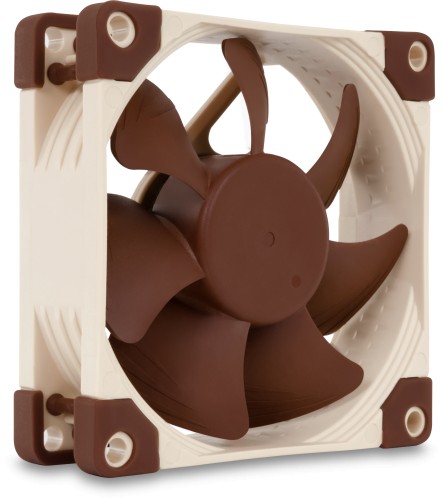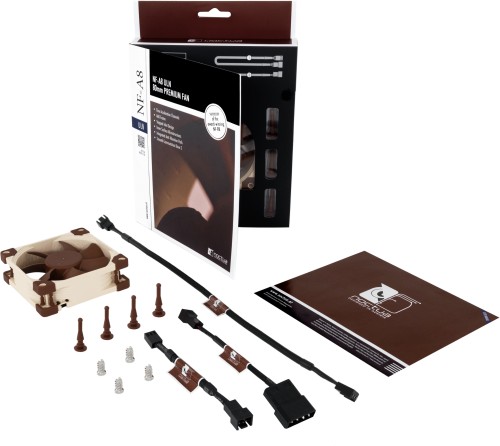Noctua NF-A8 ULN 12V 1400RPM 80mm Premium Quality Fan
Noctua’s new 80mm fans have been updated to feature their innovative technology. The NF-A8 ULN is their quietest 80mm fan, especially when used with the U.L.N.A., only 6.5dB(A).
Features
- Sound-optimised blade geometry and profile (Flow Acceleration Channels)
- Self-stabilising oil-pressure bearing (SSO2 Bearing)
- <7 dB(A) minimum noise with supplied U.L.N.A.
- 20.5 CFM maximum airflow
- Includes 4 Vibration-Compensators
- Six years warranty
The NF-A8 is a highly optimised, premium quality quiet 80mm fan. Featuring Noctua’s AAO (Advanced Acoustic Optimisation) frame as well as sophisticated aerodynamic design measures such as Flow Acceleration Channels, the NF-A8 further improves the renowned quiet cooling performance of the award-winning NF-R8. The ULN version provides super-slow 1400/1100rpm speed settings for ultra-low-noise applications and highly noise-sensitive users who demand near silent operation. Its superb running smoothness, reference-class SSO2 bearing and Noctua’s trusted premium quality make it an elite choice for the highest demands.
| Specifications | NF-A8 ULN |
|---|---|
| Size | 80x80x25 mm |
| Connector | 3-pin |
| Bearing | SSO2-Bearing |
| Blade Geometry | A-Series with Flow Acceleration Channels |
| Rotational Speed (±10%) | 1400 RPM |
| Rotational Speed with U.L.N.A. (±10%) | 1100 RPM |
| Airflow | 20.5 CFM |
| Airflow with U.L.N.A. | 15.1 CFM |
| Acoustical Noise | 10.4 dB(A) |
| Acoustical Noise with U.L.N.A. | 6.5 dB(A) |
| Static Pressure | 1.05 mm H2O |
| Static Pressure with U.L.N.A. | 0.61 mm H2O |
| Input Power | 0.6 W |
| Input Current | 0.05 A |
| Voltage | 12 V |
| Accessories | Ultra-Low-Noise Adaptor (U.L.N.A.), 3:4-Pin Adaptor, 30cm Extension Cable, |
| Warranty | 72 months |
| EAN barcode | 4716123315490 |
| Specifications | NF-A8 ULN |
|---|---|
| Size | 80x80x25 mm |
| Connector | 3-pin |
| Bearing | SSO2-Bearing |
| Blade Geometry | A-Series with Flow Acceleration Channels |
| Rotational Speed (±10%) | 1400 RPM |
| Rotational Speed with U.L.N.A. (±10%) | 1100 RPM |
| Airflow | 20.5 CFM |
| Airflow with U.L.N.A. | 15.1 CFM |
| Acoustical Noise | 10.4 dB(A) |
| Acoustical Noise with U.L.N.A. | 6.5 dB(A) |
| Static Pressure | 1.05 mm H2O |
| Static Pressure with U.L.N.A. | 0.61 mm H2O |
| Input Power | 0.6 W |
| Input Current | 0.05 A |
| Voltage | 12 V |
| Accessories | Ultra-Low-Noise Adaptor (U.L.N.A.), 3:4-Pin Adaptor, 30cm Extension Cable, |
| Warranty | 72 months |
| EAN barcode | 4716123315490 |
Customer Reviews
These just ooooooooooze quality
WOW. It’s nice to treat yourself sometimes and purchase a little luxury that just oozes quality. Even the packaging is wonderful. A door on the front is secured with Velcro and allows you to view the contents and information easily. Getting inside is a pleasant surprise too. No welded plastic cartons here. The inner pack slides out of the card case, and the plastic cover just lifts off. The rubber anti-vibration mounts each have their own little pocket, as do the accessory cable. Each cable is also labelled and the wires are secreted away inside a black over-braid secured with matte-black heat shrink. It’s a shame to hide them in a case. All in all, it makes you feel like you’ve made a very special purchase. It’s not often you get a warm fuzzy feeling just from some packaging!
But it’s not just about quality packaging, it’s the performance that really shines.
Well, my previous case ran 3x 80mm non-Noctua fans: rear case extraction, CPU, and PSU. Each fan ran 19.6CFM at 15dB, and typical system temps were about 40degC. With the help of a new NoFen CS-30 case, I’m now running only 2x of these new Noctua ULN fans, one in the PSU running 15CFM & 6.5dB @ 1,100rpm (ULNA installed), and another on the CPU, but it tends to be run by the BIOS at just 700rpm, so presumably less than 15CFM and 6.5dB. The result… system temps around 37degC and so little noise that the loudest thing is the faint electrical whine from my monitor and speakers! For reference my CPU has a TDP of 65W and still runs the OEM heat sink.
With this basic setup, there might not be any point (for me at least) going totally fanless on the CPU and PSU as the loudest thing now is the electronic circuits themselves.
All in all, these fans are just wonderful.
Product Resources
FAQ
How do I measure fan size?
The size of fan you need will generally be determined by the size of the fan fitting position in your PC case. The sizes of all the fans on our website are shown as measured along any one of the fan’s four sides, NOT the distance between the fan’s screw holes! Our most popular fan size is 120mm, followed by 80mm. This isn’t really dictated by customer preference, but more by recent designs of PC cases.
As for the thickness (depth) of the fan, generally 25mm (1 inch) is by far the most common depth, although smaller fans can have shallower depths such as 15mm or even 10mm. All our fans are 25mm thick unless otherwise stated. If you have any questions about which fan you should order, please don’t hesitate to get in touch.
If you know the distance between the fan mounting screw holes but don’t know what fan size to order, please see the following table. Note that the mounting hole measurements shown below are taken horizontally or vertically between the holes and not diagonally.
Screw hole spacings and fan sizes
Space Between Screw Holes Fan Size 32mm 40mm 40mm 50mm 50mm 60mm 60mm 70mm 72mm 80mm 83mm 92mm 105mm 120mm I received a small cable (resistor) with my fan; what is it for?
The resistor cable (also called Ultra Low Noise or ULN cable) is designed to allow the fan to run slightly slower for even quieter operation. The benefit in lower running noise is significant. Although the airflow will be reduced slightly, this usually has minimal effect on PC temperature. We would generally recommend using the ULN resistor cable for best results in almost all circumstances.
How can I tell which way the air blows through the fan?
Hold the fan so that the round fan sticker is facing you. You are looking at the rear of the fan. When you plug the fan in, the air will be blowing towards you. If you want a fan to act as an air intake, then the fan sticker will be facing the inside of the case. Some fans also have two small arrows moulded into their plastic housing - one arrow shows the direction of airflow, and the other (at 90°) shows the direction of blade rotation.
Is it possible to use a 4-pin PWM fan or CPU cooler with a motherboard which has only 3-pin fan headers on it?
Electrically, there is no problem doing this - the fourth pin on the fan cable is used purely for PWM control and is not needed in order for the fan to run. So you can plug the 4-pin fan connector onto the 3-pin motherboard fan header, leaving the fourth pin not connected to anything. The fan will potentially run at full speed, so if you would like to reduce the speed of the fan you will need to adjust the fan speed setting in your BIOS or use fan control software such as SpeedFan in Windows.
The only other problem to consider is that occasionally, components immediately adjacent to the motherboard fan header can get in the way of the larger 4-pin fan connector, physically preventing connection. This problem also occurs if you try to use an in-line fan speed controller such as the one made by Gelid.
Another avenue to explore is the possibility of using a bay-mounted fan controller. Several models are available now which provide 4-pin fan headers, so this is an easy way to use 4-pin PWM fans in a PC system which has only 3-pin fan headers on its motherboards. When using this method, you may find it necessary to disable any fan warning settings in your motherboard BIOS, since the motherboard may incorrectly believe that its CPU fan has failed when the fan is connected to a fan controller rather than directly to the motherboard itself.
Top Quiet Fans

Noctua NF-A20 PWM 5V 800RPM 200x30mm Extra Large Quiet Fan

Noctua NF-A12x25 PWM chromax.black.swap 12V 2000RPM 120mm Fan

Noctua NF-S12B REDUX 12V 700RPM 120mm Quiet Case Fan

Noctua NF-A6x25 PWM 12V 3000RPM 60x25mm Low Noise Fan
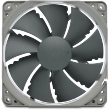
Noctua NF-P12 REDUX PWM 12V 1700RPM 120mm Quiet Case Fan
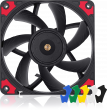
Noctua NF-A12x15 PWM chromax.black.swap 12V 1850RPM 120x15mm Fan

Noctua NF-A14 PWM chromax.black.swap 12V 1500RPM 140mm Fan

Noctua NF-F12 iPPC PWM 12V 3000RPM 120mm High Performance Fan

Noctua NF-A14 PWM 12V 1500RPM 140mm Premium Quality Fan
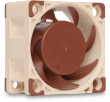
Noctua NF-A4x20 PWM 12V 5000RPM 40x20mm Quiet Cooling Fan

